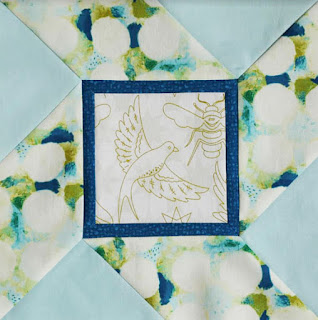Yankee Notions #1
Open Book by Denniele Bohannon
12"
We'll begin the Yankee Notions series with a block about the idea of literacy and the value New Englanders have placed on education since the first Puritans landed.
Yankee schoolteachers spread these ideas in the South before, during and after the Civil War.
Southerners, of course, resented the often-heard criticism that they were ignorant and illiterate. Confederate diarist Mary Boykin Chesnut took delight in describing the spelling errors found in letters scattered on battlefields among the dead soldiers.
The concept of free public schools was a Yankee Notion that divided the country, as was the idea of public taxes to support those schools. Schools cost money; good schools cost lots of money. Who is willing to pay for it?
Virginia Governor William B. Giles (1762-1830) spoke for many when he criticized the Jeffersonian ideal of public education. Schooling the boys of Virginia would make them unfit for farm and other manual labor that was their lot; hiring teachers would create a voting class with a special interest in the high taxes schools demanded and it was not fair to levy taxes on one taxpayer to benefit another's child.
Yankee schoolteacher Laura Towne (1825-1901) with
Dick, Maria and Amoretta in Union-occupied
South Carolina sometime after 1862.
Graphic showing the proportion of illiteracy in the states in 1850, from an 1870 Report by the Commissioner of Education based on the censuses. Dots do not show numbers but rather proportions with New Hampshire and Connecticut having the fewest people who cannot read as a basis for comparison.
"Wherever the Yankee soldier has tramped the Yankee Schoolmarm will teach. Noble and chivalric gentlemen may throw stones at her windows, burn her schoolhouse, drive her from their neighborhood; but she reappears---she, or her cousin...." Atlantic Monthly 1869.
Southerners, of course, resented the often-heard criticism that they were ignorant and illiterate. Confederate diarist Mary Boykin Chesnut took delight in describing the spelling errors found in letters scattered on battlefields among the dead soldiers.
"Free schools are not everything, as witness this spelling. Yankee epistles from camp show how illiterate they can be, with all their boasted schools. Fredericksburg is spelled 'Fredrexbirg,' medicine, 'metison'...."
Western Female Institute, Ohio
The concept of free public schools was a Yankee Notion that divided the country, as was the idea of public taxes to support those schools. Schools cost money; good schools cost lots of money. Who is willing to pay for it?
Virginia Governor William B. Giles (1762-1830) spoke for many when he criticized the Jeffersonian ideal of public education. Schooling the boys of Virginia would make them unfit for farm and other manual labor that was their lot; hiring teachers would create a voting class with a special interest in the high taxes schools demanded and it was not fair to levy taxes on one taxpayer to benefit another's child.
The Block
Chocolate & Cinnamon traditions
BlockBase #2597 has been published with many names over the past century. Open Book is from a catalog identified as Needlecraft Supply in the 1930s.
The pattern is older. The block above is dated 1872.
Sorry about the Y seams.
Each month you'll get patterns for two sizes: 12" or 18" Blocks.
A - Cut 4 parallelograms from a strip 3-1/2" wide at 45 degrees. The base should be 6-3/4" long.
B - Cut 1 square 7-1/4". Cut into four triangles with two diagonal cuts.
C - Cut 1 square 6-1/2".
B - Cut 1 square 10-1/4". Cut into four triangles with two diagonal cuts.
C - Cut 1 square 9-1/2".
12" Block
B - Cut 1 square 7-1/4". Cut into four triangles with two diagonal cuts.
C - Cut 1 square 6-1/2".
18" Block
A - Cut 4 parallelograms from a strip 5" wide at 45 degrees. The base should be 9-3/4" long.B - Cut 1 square 10-1/4". Cut into four triangles with two diagonal cuts.
C - Cut 1 square 9-1/2".
How-To
Open Book by Dorry Emmer
She's using some notions fabric in one set of blocks.
A Tangible Yankee Notion
Thimble
Thimbles (the German word is Fingerhut which explains the concept nicely) have been around since humans invented needles. Made of various materials, particularly leather and metals, they can be hand made or manufactured.
Manufactured metal thimbles were one of the sewing notions a Yankee Peddler would carry to housewife customers north and south.
The Peddler's Wagon by Charles Green Bush, Harper's Weekly, 1868
Thimbles commemorating Queen Victoria's
ascension to the throne and her 60th Jubilee.
Open Book by Dorry Emmer
Dorry added a frame to spotlight her flying creatures fabric in
her second set of blocks.
Open Book by Becky Brown
And Becky added pieces in the center square to make it a 3-color block.
Denniele is doing two sets, one 12" and this one 18".
She says that 9" square in the center needed more pattern so she cut strips:
Cut 4 orange 1-1/2" x 9-1/2" strips
Cut 5 white 1-1/2" x 9-1/2" strips
Alternating colors, piece the nine strips together.
Sign at the German Fingerhut Museum


























2 comments:
Your historical stories are wonderful and this is a lovely block. This beginner would love to have an order of sewing the pieces together. I've looked at a long time and just can't quite figure it out. Thanks.
I totally agree with "Unknown" above...an order of piecing would be so helpful...
Post a Comment